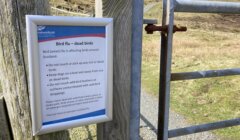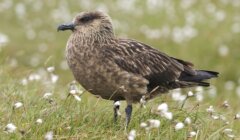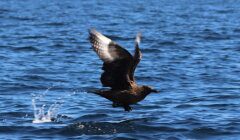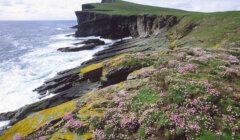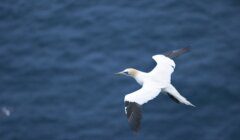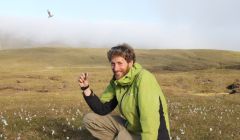Nature / Breeding population of Noss bonxies drops by nearly 80 per cent after avian flu
This year was one of the most difficult yet for the Noss and Hermaness nature reserves
THE BREEDING population of bonxies at the Noss National Nature Reserve fell by nearly 80 per cent during the year as avian flu devastated the colony, new figures show.
The numbers of breeding gannets there also dropped by 16.7 per cent.
But there is a glimmer of positivity – bonxies at Noss that survived managed to fledge chicks and breeding success for the species was better than in some previous years.
Both species, though, also suffered badly at NatureScot’s other reserve at Hermaness in Unst.
Meanwhile kittiwakes had one of their best seasons in Noss in recent years, with breeding attempts up by 58 per cent from last year.
Many kittiwake chicks were seen to fledge their nests and breeding success was up from 0.5 to 0.9 chicks fledged per pair.
Bonxies are known for preying on kittiwakes, as well as stealing their food, and the reduction in bonxie numbers possibly contributed to the successful breeding season at Noss.
Another species that bonxies are known for stealing food from is the Arctic tern, which also had an exceptional breeding season, again possibly in response to the reduction in bonxie numbers.
Other species appeared to evade the virus, including shags, guillemots, razorbills, puffins and fulmars, with numbers and breeding success of these species either on par with last year, or slightly improved.
One guillemot within a monitoring plot at Noss was discovered with a leg ring which revealed the bird to be 31 years old, having been ringed as a chick on the Isle of Canna in 1991.
Interesting migrating birds spotted on the reserve this year included a rustic bunting and greenish warbler.
However, the bird of the year was the first record on Shetland – and only the second in Scotland – of a Pacific swift, which was spotted hawking for insects at the Noup, the highest point on the island.
Become a member of Shetland News
The Noup of Noss is well known for attracting rare swifts, with an Alpine swift spotted in 1994 and a white-throated needletail in 1991.
Meanwhile at Hermaness a record number of people visited the reserve in 2022, exceeding the 10,000 mark for the first time.
Staff were said to be delighted to open the new boardwalk and information hub, enhancing the visitor experience at the most northerly NNR – or National Nature Reserve – in Britain.
Nearly two kilometres of recycled plastic boardwalk was installed, which opens up a circular route known as the Muckle Flugga Trail through the centre of the reserve, while protecting fragile peatland and avoiding disturbing sensitive nesting birds.
A new visitor shelter, with seasonal toilets and year-round information, was also built at the car park, and signs installed along the trails.
The project was made possible through a partnership of NatureScot, VisitScotland and Shetland Islands Council, with funding from the Natural and Cultural Heritage Fund and Rural Tourism Infrastructure Fund.
NatureScot operations officer in Shetland Juan Brown said: “This year has undoubtedly been one of the most difficult for our nature reserves on Shetland.
“Seeing the devastating impact of avian flu as it swept through the bonxie and gannet colonies in the summer was heartbreaking, and we were saddened to have to take the necessary step of closing Noss and restricting access at Hermaness to try and help prevent the spread.
“Given that 60 per cent of the world’s population of great skua nests in Scotland, the majority in the Northern Isles, this is very concerning.
“As we head into 2023, Scotland’s avian flu task force, led by NatureScot, is continuing to work flat out to gain a better understanding of the virus and take the necessary action on the ground to protect our wild birds.
“Thankfully there were some glimmers of hope on the reserves in 2022, as other species seemed to avoid the worst of the outbreak and went on to have successful breeding seasons, and visitors enjoyed huge improvements to facilities.
“And there have been some fantastic discoveries, including one of the oldest guillemots we’ve recorded here.”
NatureScot chief executive Francesca Osowska said: “This year has been a challenging one for nature in Scotland, as we saw an unprecedented avian flu outbreak that took a devastating toll on our wild birds, with NatureScot leading the national response to the crisis.
“As we look back on 2022, it’s heartening to hear some more hopeful stories from our National Nature Reserves and reflect on the great work staff are doing on the ground for nature and people.”
Become a member of Shetland News
Shetland News is asking its many readers to consider paying for membership to get additional features and services: -
- Remove non-local ads;
- Bookmark posts to read later;
- Exclusive curated weekly newsletter;
- Hide membership messages;
- Comments open for discussion.
If you appreciate what we do and feel strongly about impartial local journalism, then please become a member of Shetland News by either making a single payment, or setting up a monthly, quarterly or yearly subscription.



































